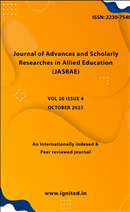Saudi Arabia's emergency medical Technician: Features and distribution
Keywords:
emergency medical services, EMS workforce, sociodemographic characteristics, educational backgrounds, Saudi ArabiaAbstract
Background Emergency medical services (EMS) are a vital gateway to the healthcare system ona global scale. Gaining knowledge on the EMS workforce's professional, educational, and demographiccharacteristics is crucial. Aim Examining the characteristics and distribution of the EMS workforce as wellas the sociodemographic and educational backgrounds of Saudi Arabia's certified EMS providers are thegoals. Methods We included all Saudi Arabian EMS providers with licenses to the SCFHS database.Sociodemographic data, certification status, and employment associations were gathered and organized.Result Most graduates with an EMT diploma or less come from private, military-affiliated, overseas, andSRCA institutions and academies. On the other hand, the majority of public college graduates have abachelor's degree. Conclusion Achieving a suitable EMS provider-to-population ratio depends on theEMS workforce growing, particularly the hiring of more females and EMS experts relative to EMStechnicians and health aides.References
EMS. Emergency Medical Service, 24/ 7 Care Everywhere, National Highway Traffic Safety Administration, 2007.
Bigham BL, Buick JE, Brooks SC, Morrison M, Shojania KG, et al. Patient safety in emergency medical services: a systematic review of the literature. Prehospital Emergency Care, 2011 16: 20-35.
Heyworth J Emergency medicine-quality indicators: the United Kingdom perspective. Acad Emerg Med, 2011 18: 1239-1241.
Almalki M, Fitzgerald G, Clark M Health care system in Saudi Arabia: An overview. East Mediterr Health J, 2011 17(10): 784-793.
Alanazi AF Emergency medical services in Saudi Arabia: A study on the significance of paramedics and their experiences on barriers as inhibitors of their efficiency. Int J Appl Basic Med Res , 2012 2: 34-37.
MH (2013) Guidelines for Emergency Department, Ministry of Health, Kingdom of Saudi Arabia.
Khattab E, Sabbagh A, Aljerian N, et al. Emergency medicine in Saudi Arabia: a century of progress and a bright vision for the future. Int J Emerg Med., 2012 2019;12(1):1–8. doi:10.1186/s12245-019-0232-0
Memish ZA, McNabb SJN, Mahoney F, Alrabiah F, Marano N, et al. Establishment of public health security in Saudi Arabia for the 2009 Hajj in response to pandemic influenza AH1N1. The Lancet, 2009 374: 1786-1791.
Sagarin MJ, Barton ED, Chng YM, Walls RM, National Emergency Airway Registry (NEAR) Investigators Airway management by US and Canadian emergency medicine residents: A multicenter analysis of more than 6,000 endotracheal intubation attempts. Ann Emer Med, 2005 46: 328-336.
Al-Habib A, A-shail A, Alaqeel A, Zamakhshary M, Al-bedah K, et al. Causes and patterns of adult traumatic head injuries in Saudi Arabia: implications for injury prevention. Ann Saudi Med, 2013 33: 351-355.
Qureshi N International Perspective from Saudi Arabia on “Procedural Skills Training During Emergency Medicine Residency: Are We Teaching the Right Things?”. West J Emerg Med, 2009 10: 157.
Alagappan K, Holliman CJ History of the development of international emergency medicine. Emerg Med Clin North Am, 2005 23: 1-10.
McGaghie WC, Issenberg SB, Cohen MER, Barsuk JH, Wayne DB Does simulation-based medical education with deliberate practice yield better results than traditional clinical education? A meta-analytic comparative review of the evidence. Acad Med, 2011 86: 706-711.
Alghamdi K, Alburaih A, Wagner MJ A Comparison between Emergency Medicine Residency Training Programs in the United States and Saudi Arabia from the Residents’ Perception. Emerg Med Int:, 2014 362624.
Sun BC, Hsia RY, Weiss RE, Zingmond D, Liang LJ, et al. Effect of emergency department crowding on outcomes of admitted patients. Annals of Emergency Medicine, 2013 61: 605-611.
Alyasin A, Douglas C Reasons for non-urgent presentations to the emergency department in Saudi Arabia. Int Emer Nur, 2014 22: 220-225.
Dainty KN, Jensen JL, Bigham BL, Blanchard IE, Brown LH, et al. Developing a Canadian emergency medical services research agenda: a baseline study of stakeholder opinions. CJEM, 2013 15: 83-89.
Rehmani R, Norain A Trends in emergency department utilization in a hospital in the Eastern region of Saudi Arabia. Saudi Med, 2007 Jour 28: 236-240.








